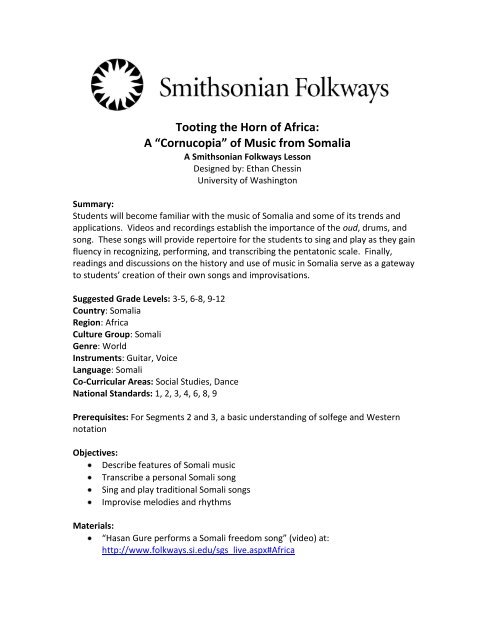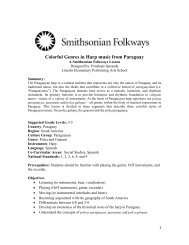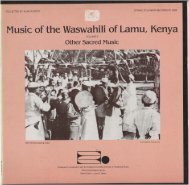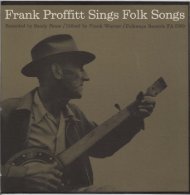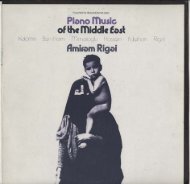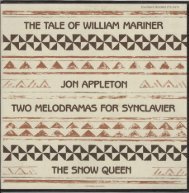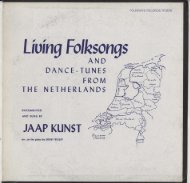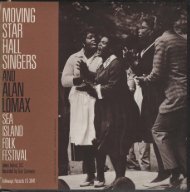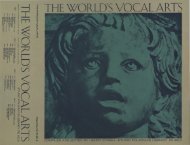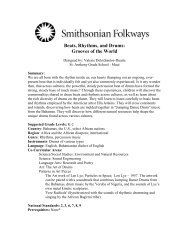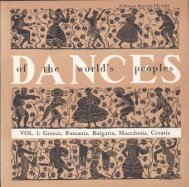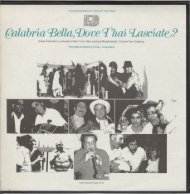Tooting the Horn of Africa: A “Cornucopia” of Music from Somalia
Tooting the Horn of Africa: A “Cornucopia” of Music from Somalia
Tooting the Horn of Africa: A “Cornucopia” of Music from Somalia
You also want an ePaper? Increase the reach of your titles
YUMPU automatically turns print PDFs into web optimized ePapers that Google loves.
<strong>Tooting</strong> <strong>the</strong> <strong>Horn</strong> <strong>of</strong> <strong>Africa</strong>:<br />
A <strong>“Cornucopia”</strong> <strong>of</strong> <strong>Music</strong> <strong>from</strong> <strong>Somalia</strong><br />
A Smithsonian Folkways Lesson<br />
Designed by: Ethan Chessin<br />
University <strong>of</strong> Washington<br />
Summary:<br />
Students will become familiar with <strong>the</strong> music <strong>of</strong> <strong>Somalia</strong> and some <strong>of</strong> its trends and<br />
applications. Videos and recordings establish <strong>the</strong> importance <strong>of</strong> <strong>the</strong> oud, drums, and<br />
song. These songs will provide repertoire for <strong>the</strong> students to sing and play as <strong>the</strong>y gain<br />
fluency in recognizing, performing, and transcribing <strong>the</strong> pentatonic scale. Finally,<br />
readings and discussions on <strong>the</strong> history and use <strong>of</strong> music in <strong>Somalia</strong> serve as a gateway<br />
to students’ creation <strong>of</strong> <strong>the</strong>ir own songs and improvisations.<br />
Suggested Grade Levels: 3-5, 6-8, 9-12<br />
Country: <strong>Somalia</strong><br />
Region: <strong>Africa</strong><br />
Culture Group: Somali<br />
Genre: World<br />
Instruments: Guitar, Voice<br />
Language: Somali<br />
Co-Curricular Areas: Social Studies, Dance<br />
National Standards: 1, 2, 3, 4, 6, 8, 9<br />
Prerequisites: For Segments 2 and 3, a basic understanding <strong>of</strong> solfege and Western<br />
notation<br />
Objectives:<br />
Describe features <strong>of</strong> Somali music<br />
Transcribe a personal Somali song<br />
Sing and play traditional Somali songs<br />
Improvise melodies and rhythms<br />
Materials:<br />
“Hasan Gure performs a Somali freedom song” (video) at:<br />
http://www.folkways.si.edu/sgs_live.aspx#<strong>Africa</strong>
“Kasikazi Vuma, Oh, Wind <strong>of</strong> <strong>the</strong> Southwest Mountain” <strong>from</strong> “Baijun Ballads:<br />
Somali Songs in Swahili” (SFW08504)<br />
http://www.folkways.si.edu/trackdetail.aspx?itemid=20297<br />
Lesson Segments:<br />
1. Songs & Instruments <strong>of</strong> <strong>Somalia</strong> (National Standards 1, 2, 6, 9)<br />
2. Composing and Improvising Somali Song and Dance Forms (National Standards<br />
3, 4, 8)<br />
1. Songs & Instruments <strong>of</strong> Somali<br />
Objectives:<br />
o While watching and listening to examples, students will be able to<br />
describe <strong>the</strong> major instruments and components <strong>of</strong> Somali music<br />
o Students will be able to play and sing along with “Kasikazi Vuma”<br />
Students will make connections <strong>from</strong> <strong>the</strong> song lyrics to modern<br />
Somali culture and current events<br />
Materials:<br />
o “Hasan Gure performs a Somali freedom song” (video) at:<br />
http://www.folkways.si.edu/sgs_live.aspx#<strong>Africa</strong><br />
o “Kasikazi Vuma, Oh, Wind <strong>of</strong> <strong>the</strong> Southwest Mountain” <strong>from</strong><br />
“Baijun Ballads: Somali Songs in Swahili” (SFW08504)<br />
http://www.folkways.si.edu/trackdetail.aspx?itemid=20297<br />
o Liner notes <strong>from</strong> “Baijun Ballads”<br />
o Classroom percussion instruments and o<strong>the</strong>r resonant objects<br />
Procedure:<br />
a. Watch video <strong>of</strong> Hasan Gure. Use <strong>the</strong> following as directing<br />
questions:<br />
i. What is <strong>the</strong> name <strong>of</strong> <strong>the</strong> instrument?<br />
ii. What is this song about?<br />
iii. How many strings does <strong>the</strong> oud have?<br />
iv. How is <strong>the</strong> music being played different <strong>from</strong> <strong>the</strong> melody<br />
being sung?<br />
v. Does <strong>the</strong> melody ever repeat? Or is <strong>the</strong> music always<br />
new?<br />
b. Listen to “Kasikazi Vuma (Oh, Wind <strong>of</strong> <strong>the</strong> Southwest Mountain)”<br />
i. Have students tap <strong>the</strong> strong beats.<br />
ii. Have students pat <strong>the</strong> percussion parts in <strong>the</strong>ir laps<br />
iii. Using classroom percussion and improvised instruments<br />
play percussion parts. Talk about <strong>the</strong> Somali practice <strong>of</strong><br />
using various items as drums.
iv. Look at <strong>the</strong> lyrics and talk about <strong>the</strong>m. Use <strong>the</strong> following<br />
questions to guide <strong>the</strong> discussion:<br />
1. What can we learn about this culture <strong>from</strong> <strong>the</strong><br />
song?<br />
2. Why are Somalis reliant on <strong>the</strong> sea?<br />
3. What are <strong>the</strong> people in this song doing?<br />
4. What connections can we make to <strong>the</strong> current<br />
problem <strong>of</strong> <strong>Somalia</strong>n piracy?<br />
v. Sing along with <strong>the</strong> chorus.<br />
Assessment: Students will be able to sing “Kasikazi Vuma” while playing appropriate<br />
percussion parts without assistance by <strong>the</strong> teacher (or while teacher plays <strong>the</strong> simple<br />
melody on a single-line instrument).<br />
2. Composing and Improvising Somali Song and Dance Forms<br />
Prerequisite: Basic understanding <strong>of</strong> solfege and Western music notation<br />
Objectives:<br />
o Students will improvise a melody over a rhythmic pattern and<br />
harmonic drone<br />
o Students will compose a rhythmic pattern and pentatonic melody<br />
for a selected poem<br />
o Students will connect musical skills to movement skills by dancing<br />
to improvised melodies<br />
Materials:<br />
o Soprano recorders or classroom instruments<br />
o Culture and Customs <strong>of</strong> <strong>Somalia</strong> by M. Diriye Abdullahi<br />
o Poetry books<br />
o Blank staff paper<br />
Procedure:<br />
a. Improvisation<br />
i. Read chapter on <strong>Music</strong> and Dance <strong>from</strong> Culture and<br />
Customs <strong>of</strong> <strong>Somalia</strong> by M. Diriye Abdullahi; have students<br />
describe how a Somali folk dance might seem<br />
ii. On recorders or classroom instruments, have <strong>the</strong> students<br />
play <strong>the</strong> minor pentatonic scale<br />
iii. Have students sing <strong>the</strong> minor pentatonic scale on solfege<br />
iv. Have students stand in a circle and keep <strong>the</strong> beat by<br />
stepping left to right and clapping a simple pattern<br />
v. Invite several students to maintain a drone on A and E on<br />
recorders or o<strong>the</strong>r instruments
vi. Imitate a Somali folk dance<br />
1. During this rhythmic pattern and harmonic drone,<br />
choose one student to act as <strong>the</strong> lead singer; have<br />
that student sing a simple compliment to <strong>the</strong> next<br />
student in line, improvising a melody <strong>from</strong> <strong>the</strong><br />
potential tones in <strong>the</strong> minor pentatonic scale.<br />
2. The next student moves into <strong>the</strong> center and dances<br />
for eight counts while <strong>the</strong> rest <strong>of</strong> <strong>the</strong> students<br />
keep time<br />
3. This student <strong>the</strong>n becomes <strong>the</strong> lead singer, and <strong>the</strong><br />
process continues until each student has had a<br />
turn<br />
b. Composition<br />
i. Read chapter on <strong>Music</strong> and Dance <strong>from</strong> Culture and<br />
customs <strong>of</strong> <strong>Somalia</strong> by M. Diriye Abdullahi. Discuss <strong>the</strong><br />
relationship <strong>of</strong> Somali poetry and traditional music<br />
ii. Have each student find a poem he or she likes<br />
iii. Read <strong>the</strong> poem out loud and try to find <strong>the</strong> underlying<br />
rhythm<br />
iv. Play this rhythm on a drum<br />
v. Transcribe <strong>the</strong> rhythm<br />
vi. Using <strong>the</strong> pentatonic scale, write a melody that fits <strong>the</strong><br />
poem<br />
vii. Have each student perform <strong>the</strong>ir own poem while ano<strong>the</strong>r<br />
student plays <strong>the</strong> drum part<br />
Assessment:<br />
Students will be able to improvise melodies that correctly use <strong>the</strong> minor<br />
pentatonic scale while keeping a steady rhythm.<br />
Students will compose a melody to fit a poem <strong>of</strong> <strong>the</strong>ir choice and perform it for<br />
<strong>the</strong>ir classmates.


